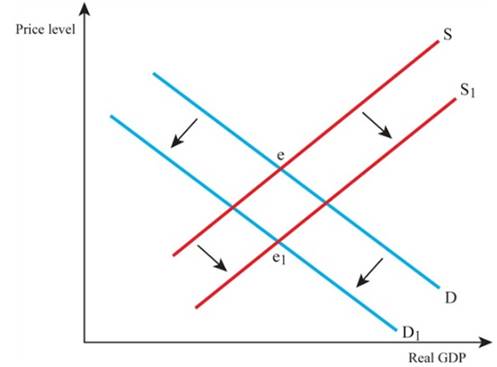
To Analyze: The effects of currency appreciation by using an
Explanation of Solution
The relationship between supply of quantity and cost of goods or services, when represented graphically, it is called a supply curve. The point at which the supplied quantity equals the demanded quantity, then that is called an
Below shown is the diagram that represents the appreciation of currency in an economy.

In the above mentioned graph the real
Want to see more full solutions like this?
- Assume in a given month, Japan's export to the U.S. increased. How such an increase will affect the Japanese Yen? From a U.S. perspective, how this increase will affect the U.S. dollar? Knowing that both currencies can float, verbally explain your answers using the demand/supply model (no need to draw a graph).arrow_forwardUse the excel file above to answer the following question. Which countries have a premium value of the dollar?arrow_forwardIf a strike takes place in France, making it harder to buyFrench goods, what will happen to the value of the U.S.dollar?arrow_forward
- Which of the following gives rise to transaction demand for a currency? A Chinese investor buys U.S. T-bonds, expecting dollars to appreciate. The Bank of Japan sells yen in the foreign currency markets. A Japanese car maker pays a U.S. engine manufacturer in dollars.arrow_forwardExplain how changes in exchange rates impact the economy through the aggregate demand- aggregate supply (AD/AS) model. Explain how fluctuations in exchange rates can influence loans and banks.arrow_forwardSuppose country A’s goods becomes more popular with foreign consumers, and country B’s less so. How would this affect each country, assuming that they (a) have their own independent currency and (b) share a common currency? Use the Aggregate Demand and Aggregate Supply framework to explain your answer, and comment briefly on the desirability of currency union.arrow_forward
- Suppose country A’s goods become more popular with foreign consumers, and country B’s less so. How would this affect each country, assuming that they (a) have their own independent currency and (b) share a common currency? Use the aggregate demand (AD) and aggregate supply (AS) framework to explain your answer, and comment briefly on the desirability of currency union.arrow_forwardDistinguish between a nominal appreciation and a real appreciation of a currency.arrow_forwardIn the foreign exchange market, the supply curve for the dollar is upward sloping. That is, when the exchange rate (foreign currency per dollar) increases, the quantity of dollars supplied increases. Assuming actors have not yet had time to change their expectations about the future exchange rate, when the exchange rate increases, why is the supply curve of dollars in the foreign exchange market upward sloping? Foreign goods and services are less expensive to import. U.S. firms profit more by selling their goods and services domestically rather than selling to foreigners. The expected profitability of purchasing a dollar today to sell in the future rises. U.S. goods are less expensive for foreigners to purchase.arrow_forward
- Construct a model that shows how – in the longer run – money supply and demand as well as the dollar return on foreign assets determine the exchange rate.arrow_forwardUsing data from The Economist's Big Mac Index for 2019, the following table shows the local currency price of a Big Mac in several countries as well as the actual exchange rate between each country and the United States. At the time of the data collection, a Big Mac would have cost you $5.74 in the United States and GBP 3.29 in the United Kingdom. The actual exchange rate between the British pound and the U.S. dollar was $1.25 per pound. The dollar price of a Big Mac purchased in the United Kingdom was, therefore, computed as follows: Dollar price of a Big Mac in the United KingdomDollar price of a Big Mac in the United Kingdom = = GBP 3.29×$1.25GBP 1.00GBP 3.29×$1.25GBP 1.00 = = $4.11$4.11 For the price you paid for a Big Mac in the United States, you could have purchased a Big Mac in the United Kingdom and had some change left over for fries! Complete the final column of the table by computing the dollar price of a Big Mac for the countries where this amount is…arrow_forwardFill in the blank using the words: positive, negative, raise, lower, improving, deteriorating, depreciate, i, Y, appreciate, raising, lowering, contraction, expansion, increase, decrease, higher, lower. During the early-1990s, Mexico maintained an exchange rate peg against the U.S. dollar (assume the peg is hard). When President Zedillo took office in December 1994, he faced several challenges. A combination of the assassination of a presidential candidate and the rebellion in Chiapas had led to an increase in the expected future exchange rate, E (the market got worried that the exchange rate peg would be abandoned in the future). According to the IS-LM-FX model, an increase in Ee will the foreign return curve in the FX market. Under a floating exchange rate, this would cause the spot exchange rate to as investors shift deposits out of Mexico expecting a return on U.S. deposits. Of course, this cannot happen under a fixed exchange rate regime (hard peg), which means Banco de Mexico…arrow_forward
 Managerial Economics: Applications, Strategies an...EconomicsISBN:9781305506381Author:James R. McGuigan, R. Charles Moyer, Frederick H.deB. HarrisPublisher:Cengage Learning
Managerial Economics: Applications, Strategies an...EconomicsISBN:9781305506381Author:James R. McGuigan, R. Charles Moyer, Frederick H.deB. HarrisPublisher:Cengage Learning
 Economics (MindTap Course List)EconomicsISBN:9781337617383Author:Roger A. ArnoldPublisher:Cengage Learning
Economics (MindTap Course List)EconomicsISBN:9781337617383Author:Roger A. ArnoldPublisher:Cengage Learning


